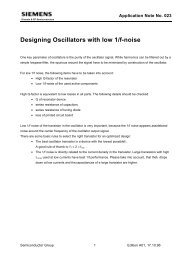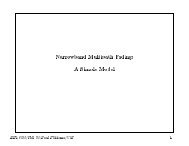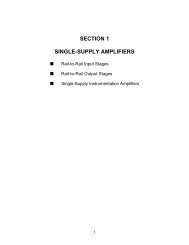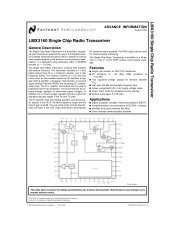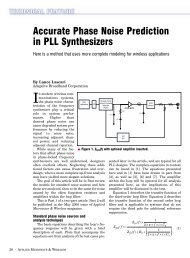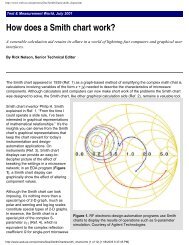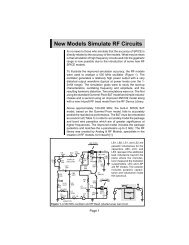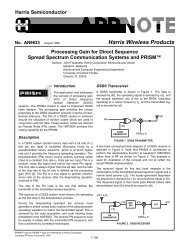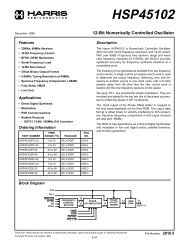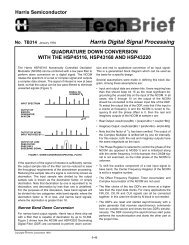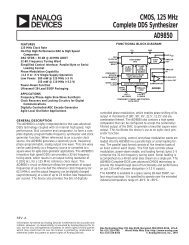Spread Spectrum - It's not just for breakfast anymore!
Spread Spectrum - It's not just for breakfast anymore!
Spread Spectrum - It's not just for breakfast anymore!
Create successful ePaper yourself
Turn your PDF publications into a flip-book with our unique Google optimized e-Paper software.
as possible. This spawns innovative and creativemethods to achieve this means. Then these meanstend to be passed back to the commercial sectorand benefit everybody.CDMA is <strong>not</strong> the exclusive province of directsequence systems; CDMA can also be used withfrequency hopping. TDMA is <strong>not</strong> the exclusiveprovince of narrowband systems; TDMA can alsobe used with direct sequence or frequency hopping.This isn't newIn the 1982 AMRAD letter (reprinted on page 4-11 of the ARRL SS Handbook), Hal Feinstein,WB3KDU, wrote,<strong>Spread</strong> spectrum has found its way into packetradio. <strong>Spread</strong> spectrum allows each node to havea unique code which acts as a hard address.A<strong>not</strong>her node in the system can send data to thatnode by encoding that data with the spreadspectrum address <strong>for</strong> the receiving node. Traffic<strong>for</strong> other nodes does <strong>not</strong> interfere because it wouldhave a different code. Among the reasons cited <strong>for</strong>employing spread spectrum <strong>for</strong> packet switchingare privacy, selected addressing, multipathprotection and band sharing. But it is interestingto <strong>not</strong>e that a load is taken off the contentioncollision approach because now a single frequencyis <strong>not</strong> in contention among the nodes wishing totransmit. The load is divided among the nodesaddresses, and each that is interested in sendingdata to a target node competes <strong>for</strong> that node only.This is the CDMA part of SS. This is one ofthose areas the FCC really wants hams toexperiment with. I think the paper has a lot ofinsight and it was even written over 13 years ago.PANSAT - A <strong>Spread</strong> <strong>Spectrum</strong> SatelliteThe Space Systems Academic Group (SSAG)at the Naval Postgraduate School (NPS) inMonterey, Cali<strong>for</strong>nia is actively designing andbuilding an amateur satellite named PANSAT (seefigure 4). PANSAT is the acronym <strong>for</strong> PetiteAmateur Navy Satellite. PANSAT is to become apacket digital store-and-<strong>for</strong>ward satellite varysimilar in capabilities as the existing PACSATs inorbit today. The tentative launch date of PANSATis late 1996, early 1997 as a Get Away Special(GAS) payload from the Space Shuttle.One big difference between today’s PACSATsand PANSAT is that PANSAT will use directsequence spread spectrum as the communicationsup and downlink.PANSAT is being designed from the ground upas an amateur satellite. The only military missionof PANSAT is as a training vehicle <strong>for</strong> theeducation of military officers in the Space SystemsCurricula by the design, fabrication, testing andoperation of a low-cost, low earth orbit (LEO),digital communications satellite. One of theengineering objectives of PANSAT includes theevaluation and per<strong>for</strong>mance of spread spectrumpacket radio communications using the Amateurcommunity as the user base.In order to facilitate the evaluation of spreadspectrum per<strong>for</strong>mance the SSAG is designing a lowcost spread spectrum modem and RF package to bepresented to the amateur community in a kit <strong>for</strong>m.The goal is to have the design of the spreadspectrum radio/modem available be<strong>for</strong>e the launchof PANSAT to allow Amateurs to build andbecome operational via terrestrial means. Thispresents an exciting exchange of technology andthe ability <strong>for</strong> the Amateur to build a low cost unitto experiment with. As the design anddevelopment progresses they will be presented inthe Amateur press.Future and SummaryNow is the time to begin experimenting withspread spectrum communications on a wider scale.Technology has advanced to the point whereAmateurs can af<strong>for</strong>d to build systems. Thebuilding blocks are available now in the <strong>for</strong>m ofApplication Specific Integrated Circuits. Therecent flood of consumer devices that employspread spectrum has also driven the price down. Inmany cases the Amateur can either use thesedevices under their present type acceptance ormodify them <strong>for</strong> Amateur operations. However,the Amateur should remain aware of the rules andregulations governing the particular device whether



